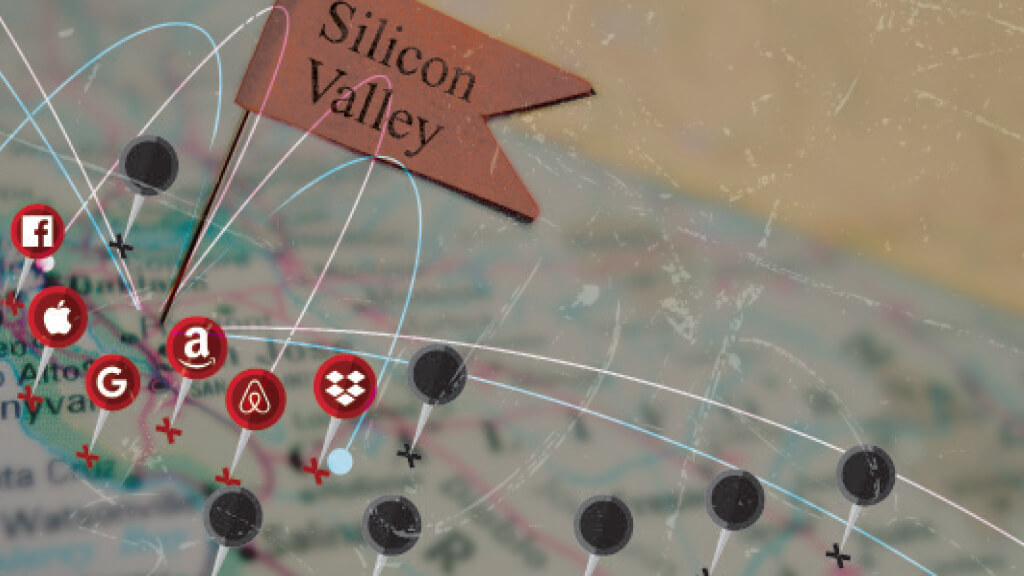It started with prunes. Long before Silicon Valley was the innovation capital of the world, it was a giant valley of fruit trees and verdant hills. The primary crop in the then called Santa Clara Valley was the French plum, which was sun-dried to turn into the valley’s most popular export and métier: prunes.
By the late 19th century, the Industrial Revolution had produced myriad millionaires, billionaires by the boatload and tons of tycoons. Among them was Leland Stanford, a railroad king. Stanford owned an 8,100-acre ranch in Santa Clara Valley near Palo Alto. That’s where he founded and established Stanford University. It was also here that the region transformed into the valley of technology known today as Silicon Valley.
In 1925, Stanford alum Frederick Terman, considered the father of Silicon Valley, returned to teach radio engineering. Over the next decade, Terman noticed something quite concerning. He recognized that Stanford produced elite, highly-educated grads who continually opted to leave town for jobs in New York City. Terman expressed his desire for Stanford alumni to stay in the valley to grow the region’s business sector and feed the local economy. The first company to heed this advice was Hewlett-Packard.
Terman encouraged Stanford grads William Hewlett and David Packard to partner up and thus, we saw the first ever “garage-startup” born. Anon this historic partnership, more alumni and faculty at Stanford began to found their own companies in the valley. Soon, a massive network of companies was formed, bound by their shared connection with the university. Terman had essentially built a pipeline through which Stanford grads poured into the valley, a process that is still in full swing today.
In a sense, Silicon Valley was the first academic incubator. One that is stronger than ever today. Or is it?
The great tech-xodus?
According to The Economist, “[In 2018,] more Americans left the county of San Francisco than arrived. According to a recent survey, 46% of respondents say they plan to leave the Bay Area in the next few years, up from 34% in 2016. So many startups are branching out into new places that the trend has a name, ‘Off Silicon Valleying.’”
Business Insider’s Melia Robinson writes, “Silicon Valley is on the brink of an exodus” and that “the tech elite are abandoning Silicon Valley in droves.”
More tellingly, Kevin Roose wrote in his New York Times article “Silicon Valley Is Over, Says Silicon Valley,” that “This isn’t a full-blow n exodus yet. But in the last three months of 2017, San Francisco lost more residents to outward migration than any other city in the country.”
Roose followed 12 venture capitalists on a bus trip throughout the heartland. They were looking for hot startups in lesser-visited areas of America. The venture capitalists were in awe of how inexpensive the home prices were in the Midwest compared to the Bay Area. To add to this, a public-relations firm named Edelman conducted a survey of 500 residents in the Bay Area and found that almost half of all Bay Area residents “said they would consider leaving California because of the cost of living.”
Moreover, Eric Rosenbaum wrote in his CNBC article “Silicon Valley Edged Out: Google Employees Aren’t the Only Ones Walking Away From Elite Tech Headquarters,” that “Silicon Valley is not about to lose its dominant position as the home of billion-dollar technology start-ups and hub for top talent, but there are a growing number of reasons why more workers and new companies are choosing other cities, far from San Francisco.”
The common theme in most of the aforementioned articles is that the reason behind this mini-exodus is the high cost of living in the Bay Area. The Economist states that “young startups pay at least four times more to operate in the Bay Area than in most other American cities.”
Aside from the cost of living, one often-cited reason why entrepreneurs leave the Valley is groupthink. Again, The Economist sheds light on this stating that, “The Valley does many things remarkably well, but it comes dangerously close to being a monoculture of white male nerds. Companies founded by women received just 2% of the funding doled out by venture capitalists last year (2017).” Entrepreneur Tim Ferriss told Business Insider that the tech scene in Silicon Valley can be brutal for people who deviate from the political echo chamber. After ten years in the Valley, Ferriss moved to Austin in 2017. Business Insider also tells the account of Peter Thiel, a billionaire-investor who was all but ostracized from Silicon Valley because of his support for President Donald Trump. He told Insider that “Network effects are very positive things, but there’s a tipping point where they fall over into the madness of crowds.”
Even if not quite an exodus, there are many accounts like the aforementioned that point to the fact that startups are indeed looking for greener pastures. Just where are these greener pastures? They are located in the business districts and technology parks that are smaller versions of Silicon Valley in cities all over the country. However, one green pasture in particular has taken the startup world by storm in recent years: the rise of the academic incubator.
A tech-splosion of university parks
“In recent years, there has been a substantial increase in public and private investment in university research parks (URPs). URPs are important as an infrastructural mechanism for the transfer of academic research findings, as a source of knowledge spillovers, and as a catalyst for national and regional economic growth,” wrote Albert N. Link and John T. Scott in the highly regarded journal Oxford Review of Economic Policy, in their article “The economics of university research parks.”
One of the biggest reasons universities have become hotbeds for tech startups is that campuses provide a means for people with multidisciplinary backgrounds to intermingle within the same space. A mechanical engineering student with a great idea might meet an MBA during a startup launch party. Together they can build and market their time-traveling DeLorean, or whatever actually-realistic idea the student has.
In essence, academic incubators are courting tech entrepreneurs because universities offer an ecosystem designed to support and grow startups from conception to commercialization. This ecosystem includes a space where researchers, faculty and students of all disciplines interact and form working relationships. In many cases, it also includes university owned equipment and laboratories for use by startup researchers.
“I feel that organizations working to commercialize university IP realize a great source of off-the-shelf technology that small businesses can use to either augment their own offerings or exploit something not currently found in the marketplace,” said Michael Tentnowski, the director of entrepreneurship for Innovation Park of Tallahassee.
“Basically, the potential business can work with university staff to perfect, enhance or create new versions of various innovations to appeal to consumer demands. Taking the technology risk out of the equation helps new businesses focus on customer discovery and market penetration,” Tentnowski explained.
Faye Liu, founder and CEO of RevoChem, a hot startup that recently launched out of UH’s Technology Bridge, expressed that “one key benefit is the easy access to great talents and research resources from both students, researchers and professors from the university with flexibility.”
Liu goes on to explain, “We have successfully hired multiple UH students and alumni through internships to work full time. We have also sponsored UH research that is relevant to our work which is a win-win for both of us.”
It is true that universities position aspiring entrepreneurs to network with the right people for building their company from the ground up. Even the Innovation Leadership Forum attests that innovation is born when different ways of thinking clash.
“Providing a high-density area for collisions between thoughts and ideas to occur is driving innovation. Our urban location – adjacent to a Tier One research university – provides the chance for success to increase exponentially,” said Carrie Roth, the president and CEO of Virginia Bio Tech Park.
“Our experience demonstrates that startups come here for a competitive advantage – and that is being in an environment where they can keep costs lower and accelerate their startup,” she continued.
Academic incubators exude a different aura from non-academic parks. There’s a certain sense of prestige they carry because they are based in universities. Perhaps it is the idea of working with professors and using university labs and equipment that resonates. “University research parks offer the opportunity for startups to be at the nexus of technology, talent and opportunities. The UH Technology Bridge, for example, offers a unique setting where companies from a broad range of technology areas can come together and have access to a variety of different resources, including wet lab space,” explained Christopher Taylor, the executive director of University of Houston’s Office of Technology Transfer and Innovation.
“Locating in a research park near a major university offers startups a chance to engage and collaborate with academic researchers in their field and leverage the vast talent pool of students through internships and part-time employment to develop their technology and grow their company,” Taylor proceeded.
Yes, it is no wonder that so many entrepreneurs are choosing to leave Silicon Valley. They actually have options now. There are a ton of alternatives available all over the country now that are just as “top tier” as Silicon Valley, without the drawbacks of living there. Chief among these alternatives are academic incubators. The explosion of university investment in these tech parks has opened, nay, kicked down, the door for startup founders looking to venture outside of the Bay Area.
Say what you will about the mini-exodus from Silicon Valley. The high cost of living, the echo chamber and political groupthink, the lack of diversity. All valid points. But one thing is for certain, there are no academic incubators today without Silicon Valley. Its influence on modern tech parks may be taken for granted, but it is real.
It was once said that as gigantic and unfathomably massive as the sun is, it still manages to gently reach out with its light, millions of miles away, to ripen a vine of grapes as if it had nothing better to do. That’s how Silicon Valley’s influence is felt. Except instead of ripening grapes, it’s drying plums. And today, academic and non-academic incubators merely operate in its shadow. The shadow of the valley of tech.



